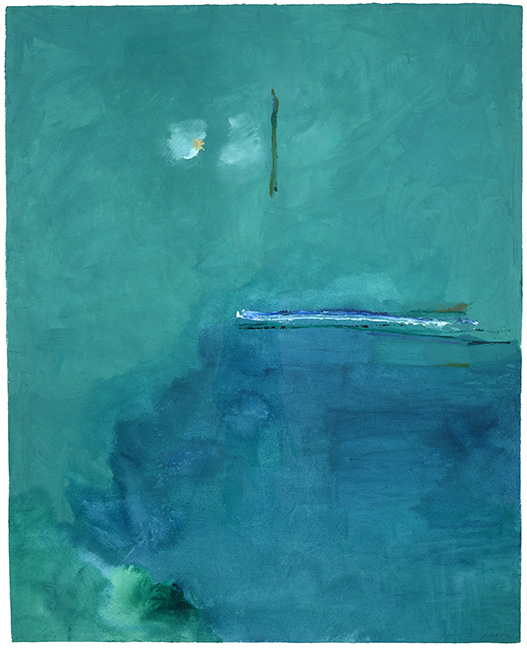Helen Frankenthaler: Late Works, 1990–2003
New Britain Museum of American Art • New Britain, CT • nbmaa.org • Through May 23, 2021
Helen Frankenthaler’s final decade brought a surge of creativity, extending her approach to materials, color, and imagery while reflecting what came before. Two dozen of Frankenthaler’s paintings on paper, spanning 1990–2003, highlight the Museum’s commitment to showcasing 20th century American art by women. Curated by Douglas Dreishpoon, director of the Helen Frankenthaler Catalog Raisonné, this exhibit of seldom seen works, exuberant to meditative, some measuring over six feet, travels to other museums after showing in Connecticut. The paintings are on loan from the Helen Frankenthaler Foundation.
Contentment Island, a six-foot painting named for the artist’s Darien, CT, address, suggests Frankenthaler’s deepening facility to evoke, with minimal means and a light touch, the natural world she once described as holding in her arms. A vertical black zip approaches a narrow horizontal black line hovering over blues. A smudge resembling charcoal peeks out, communing with a moon surrounded by wisps of clouds. This resolution of color and form, unhurried as a light wind, dances with the grace that remains Frankenthaler’s signature.

© 2021 Helen Frankenthaler Foundation, Inc./Artists Rights Society (ARS), New York. Photo: Roz Akin, courtesy Helen Frankenthaler Foundation.
Frankenthaler (1928–2011) actually loved to dance. She came of age with the Lindy Hop and the Jitterbug: friends joked, calling her a “hoofer-manqué.” In a revealing Op-Ed piece Frankenthaler wrote for the New York Times, she described the night in 1985 when she danced with John Travolta at the White House. An invitation to a soiree honoring the Prince and Princess of Wales came in the mail; she accepted.
As if in a fairy tale, she watched as the King of Saturday Night Fever danced with Princess Di. Then he was standing, alone. Frankenthaler, unaware of the elegant dancer’s identity, asked him to dance. Travolta graciously accepted. “I’d waited a lifetime for a dance like this,” she recalled.
Frankenthaler was on the fast track to legendary status within the closely knit world of New York’s abstract painters soon after graduating from Bennington College. Films show the artist on her knees, pouring, sloshing and brushing thinned acrylics over canvas sized to fit her studio floor. Movement and rhythm (she was also a dedicated swimmer) were the keys to her kingdom. Inspired by Jackson Pollock’s process of throwing and dripping thick paints onto floor-mounted canvas, she created the 7 x 10′ Mountains and Sea, her breakthrough, when she was 23.
Her imaginative capacity to suggest “the atmosphere of nature,” as Frankenthaler put it, through ribbons and veils of transparent acrylic paints, soaked and stained into unprimed, permeable canvas, became known as Color Field painting. Generations of artists, including women working in diverse mediums involving performance and sculpture, continue to be inspired by Frankenthaler’s freewheeling, intuitive approach.
Once released from the confines of an easel, or a wall, the difficulties of getting an eight-foot work through a gallery door didn’t daunt Frankenthaler’s ambition. By her 40th birthday, Frankenthaler’s diaphanous paintings were the subject of solo shows, at Manhattan’s Jewish Museum in 1960, and at the Whitney Museum of American Art a decade later.
Yet to say she took the art world by storm at an early age is only partially true. That world also pushed back, because of her youth and even more so because she was seen as “a lady painter” in what was considered a man’s game. Her coterie of early career painter-pals, Grace Hartigan and Joan Mitchell, were also exhibiting in their 20s; lively and attractive, they were made for media. The notoriety was gendered: when Life magazine pictured the trio on the cover, it was as “women who paint.” The reds, blues, and pinks she gravitated toward were seen by some as a deficit. Critics viewed her “pastels” as lacking sufficient machismo, pointing to her use of red as allusions to menstruation.
But paint she did, during six decades of experimentation, using canvases, papers, pigments, and more, made to her specifications. Restless, undeterred, her late in life choices echo the visual vocabulary and confidence of her youth. “Her creative spirit never departed,” curator Dreishpoon said, referring to Frankenthaler’s final works on paper. “Even the smallest image had vast ramifications.”
—Susan Rand Brown
